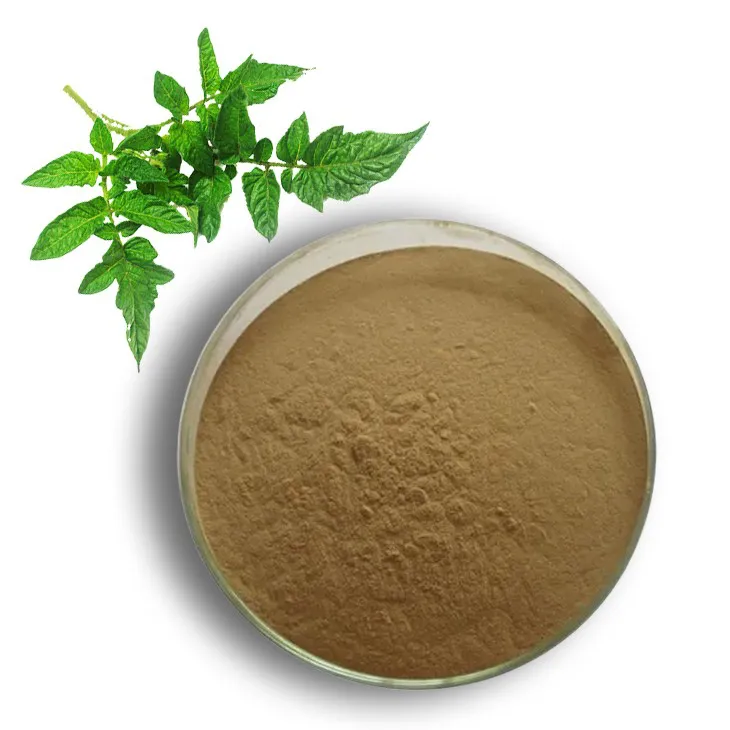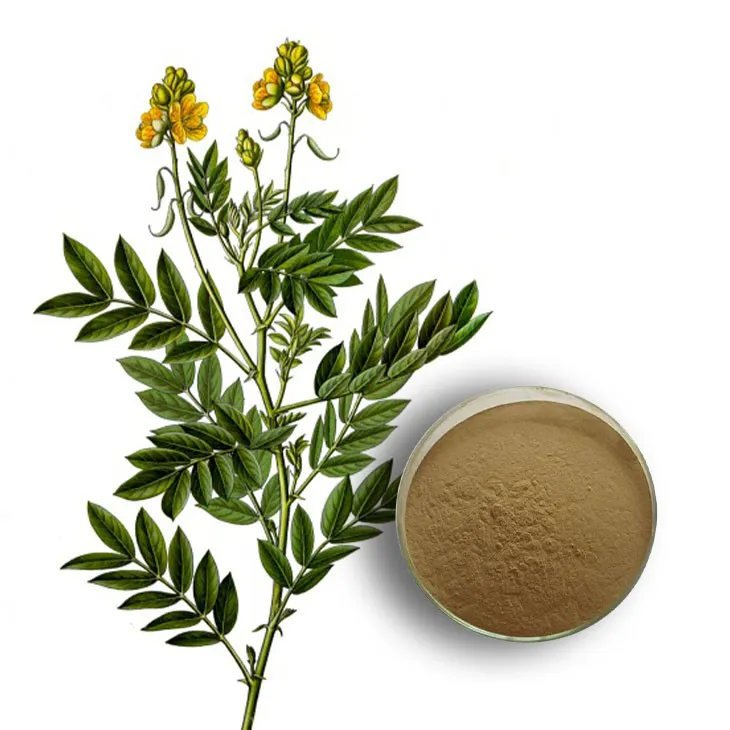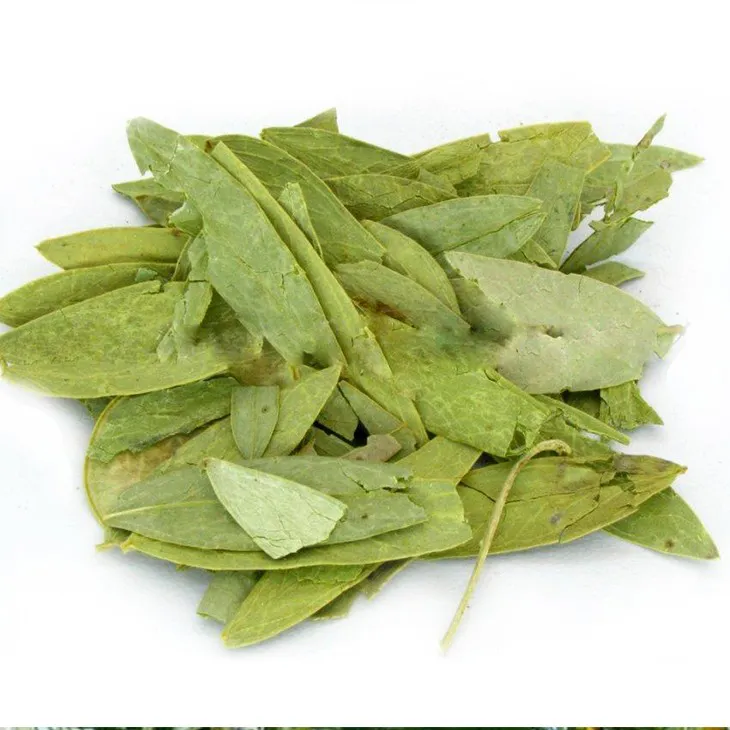- 0086-571-85302990
- sales@greenskybio.com
Optimal Bioavailability of Senna Leaf Extract.
2024-11-28

1. Introduction
Senna Leaf Extract has been widely used for its laxative properties in traditional medicine. However, for it to exert its physiological effects effectively, optimal bioavailability is crucial. Bioavailability refers to the fraction of an administered drug or substance that reaches the systemic circulation and is available at the site of action. In the case of Senna Leaf Extract, understanding the factors that influence its bioavailability can lead to more effective use and better therapeutic outcomes.

2. Physiological Factors Affecting Bioavailability
2.1 Gastrointestinal Tract Physiology
The gastrointestinal (GI) tract plays a fundamental role in the absorption of Senna Leaf Extract. The pH levels along the GI tract vary, from highly acidic in the stomach (pH around 1.5 - 3.5) to more alkaline in the small intestine (pH around 6 - 7.5). Senna leaf extract contains various compounds, and their solubility and stability can be affected by these pH changes. For example, some of the active components may be more stable and soluble in the alkaline environment of the small intestine, which could enhance their absorption.
The motility of the GI tract also affects the contact time between senna leaf extract and the absorptive surfaces. If the transit time is too fast, there may not be sufficient time for complete absorption. On the other hand, if the motility is too slow, it could lead to degradation or metabolism of the extract before absorption.
2.2 Presence of Digestive Enzymes
Digestive enzymes in the GI tract can have both positive and negative impacts on the bioavailability of senna leaf extract. Some enzymes may break down the extract into its active components, which could potentially increase absorption. For instance, certain enzymes may hydrolyze complex glycosides present in the extract, releasing the active aglycones that are more readily absorbed. However, other enzymes may metabolize the active components into inactive metabolites, reducing the bioavailability.
2.3 Intestinal Permeability
The permeability of the intestinal epithelium is a key factor. The epithelial cells lining the intestine have tight junctions that regulate the passage of substances. Some factors can modulate intestinal permeability, such as certain diseases (e.g., inflammatory bowel disease) or the use of drugs. If the intestinal permeability is increased due to an inflammatory condition, it may lead to non - specific absorption of unwanted substances along with the senna leaf extract. Conversely, if the permeability is decreased, it can impede the absorption of the extract.

3. Chemical Factors Affecting Bioavailability
3.1 Chemical Composition of Senna Leaf Extract
Senna leaf extract is a complex mixture of various compounds, including anthraquinones, flavonoids, and tannins. The anthraquinones, such as sennosides, are the main active components responsible for the laxative effect. The chemical structure of these compounds can influence their solubility, stability, and interaction with biological membranes. For example, the presence of hydroxyl groups in the anthraquinone structure can affect their polarity and thus their ability to cross lipid membranes during absorption.
The flavonoids and tannins in the extract can also interact with the active components. They may form complexes with the anthraquinones, either enhancing or reducing their bioavailability. For instance, some flavonoids may protect the active components from enzymatic degradation in the GI tract, thereby increasing bioavailability. However, excessive tannins may bind to the active components and prevent their absorption.
3.2 Formulation of the Extract
The way senna leaf extract is formulated can significantly impact its bioavailability. For example, if the extract is in a solid dosage form like a tablet, the disintegration and dissolution properties are important. A tablet that does not disintegrate quickly enough may lead to delayed absorption. On the other hand, if the extract is formulated as a liquid, the stability of the active components in the liquid medium needs to be considered. Additionally, the addition of excipients in the formulation can also affect bioavailability. Some excipients may improve solubility, while others may interact unfavorably with the active components.

4. In - vitro Studies on Bioavailability
In - vitro studies provide valuable insights into the bioavailability of senna leaf extract. These studies are typically carried out in laboratory settings using cell culture models or artificial membranes that mimic the biological environment. One common in - vitro method is to use Caco - 2 cell monolayers, which are derived from human colon carcinoma cells and are widely used to study intestinal absorption.
Using Caco - 2 cells, researchers can study the transport of the active components of senna leaf extract across the cell monolayer. They can measure the permeability coefficients and study the effects of different factors such as pH, presence of enzymes, and formulation on the transport. For example, by adjusting the pH of the culture medium on either side of the Caco - 2 cell monolayer, researchers can mimic the pH gradient in the GI tract and study how it affects the absorption of sennosides.
Another in - vitro approach is the use of artificial membranes, such as lipid bilayers. These can be used to study the interaction of the extract components with the lipid membranes, which is crucial for understanding the absorption process. By incorporating different components of the senna leaf extract into the lipid bilayer system, researchers can determine how the chemical structure of the components affects their partitioning into the membrane and subsequent transport.
5. In - vivo Studies on Bioavailability
In - vivo studies are essential to confirm the findings from in - vitro studies and to understand the overall bioavailability of senna leaf extract in a living organism. Animal models are often used in in - vivo studies. For example, rats or mice can be administered senna leaf extract, and then the levels of the active components in the blood, urine, and feces can be measured over time.
One important aspect of in - vivo studies is pharmacokinetic analysis. This involves determining parameters such as the area under the curve (AUC), which represents the total exposure of the body to the active components over time, and the maximum concentration (Cmax) reached in the blood. By comparing these parameters in different experimental groups, for example, when the extract is administered in different formulations or under different physiological conditions, researchers can assess the impact on bioavailability.
However, it should be noted that there are limitations to in - vivo studies using animal models. The physiological and metabolic processes in animals may not fully represent those in humans. Therefore, human clinical trials are also necessary to accurately determine the bioavailability of senna leaf extract in humans.
6. Strategies for Maximizing Bioavailability
6.1 Modifying the Formulation
One strategy to maximize the bioavailability of senna leaf extract is to optimize its formulation. This could involve improving the disintegration and dissolution properties of solid dosage forms. For example, using appropriate binders and disintegrants in tablet formulations can ensure quick release of the active components. In the case of liquid formulations, using stabilizers to maintain the stability of the active components can enhance bioavailability.
Another approach is to develop novel drug delivery systems for the extract. For instance, nano - or micro - particulate delivery systems can be designed. These systems can protect the active components from degradation in the GI tract and also improve their targeting to specific absorption sites in the intestine. Nano - particles can have enhanced permeability across the intestinal epithelium due to their small size, which can lead to increased bioavailability.
6.2 Co - administration with Absorption Enhancers
Co - administering senna leaf extract with absorption enhancers can also be an effective strategy. Some substances, such as certain lipids or surfactants, can increase the permeability of the intestinal epithelium. For example, medium - chain triglycerides have been shown to enhance the absorption of some drugs by disrupting the lipid bilayer of the intestinal cells. By co - administering senna leaf extract with such absorption enhancers, it may be possible to improve the bioavailability of the extract.
However, when considering co - administration, potential interactions between the extract, the absorption enhancer, and other drugs or substances in the body need to be carefully evaluated. There may be unwanted side effects or changes in the pharmacokinetic properties that need to be taken into account.
6.3 Dietary and Lifestyle Considerations
Dietary factors can play a role in the bioavailability of senna leaf extract. For example, consuming a high - fiber diet may affect the transit time in the GI tract and thus the absorption of the extract. A diet rich in certain nutrients, such as vitamins and minerals, may also influence the physiological processes involved in absorption. Additionally, lifestyle factors like regular exercise can impact GI motility and blood circulation, which in turn can affect the bioavailability of the extract.
7. Conclusion
Optimal bioavailability of senna leaf extract is a complex issue influenced by multiple physiological and chemical factors. In - vitro and in - vivo studies have provided important insights into these factors and potential strategies for maximizing bioavailability. By understanding and addressing these factors, it may be possible to improve the effectiveness of senna leaf extract in its therapeutic applications. However, further research, especially human clinical trials, is still needed to fully understand and optimize the bioavailability of this important natural extract.
FAQ:
What is bioavailability?
Bioavailability refers to the fraction of a drug or substance that reaches the systemic circulation and is available to have an active effect. In the context of senna leaf extract, it is about the proportion of the extract's active components that can be absorbed by the body.
What are the main physiological factors affecting the bioavailability of senna leaf extract?
Some of the main physiological factors include the function of the digestive system, such as the activity of enzymes in the gut, the integrity of the intestinal lining, and the rate of gastric emptying. For example, if the intestinal lining is damaged, it may impede the absorption of the extract.
What chemical factors can influence the bioavailability of senna leaf extract?
Chemical factors can involve the chemical composition of the extract itself. For instance, the presence of certain compounds that may form complexes with other substances in the gut, either enhancing or reducing absorption. Also, the solubility of the active components in the extract in different physiological fluids can play a role.
Can you give some examples of in - vitro studies related to maximizing the bioavailability of senna leaf extract?
In - vitro studies might include testing the solubility of senna leaf extract in different simulated physiological fluids. For example, researchers may study how the extract behaves in solutions that mimic the pH and composition of the stomach or intestines. They could also investigate the interaction of the extract with different cell cultures that mimic the intestinal epithelium to understand absorption mechanisms at a cellular level.
What are the potential in - vivo strategies for maximizing the bioavailability of senna leaf extract?
One potential in - vivo strategy could be the co - administration of substances that enhance gut absorption, such as certain lipids or polymers. Another strategy might involve adjusting the dosage form, for example, formulating the extract into nanoparticles to improve its absorption. Additionally, diet can also play a role; for example, consuming certain foods that can enhance the function of the digestive system may indirectly improve the bioavailability of the extract.
Related literature
- Bioavailability of Herbal Extracts: A Comprehensive Review"
- "Senna Leaf: Chemical Composition and Pharmacological Properties"
- "Enhancing Bioavailability: Strategies from Drug Development Applied to Natural Products"
- ▶ Hesperidin
- ▶ citrus bioflavonoids
- ▶ plant extract
- ▶ lycopene
- ▶ Diosmin
- ▶ Grape seed extract
- ▶ Sea buckthorn Juice Powder
- ▶ Beetroot powder
- ▶ Hops Extract
- ▶ Artichoke Extract
- ▶ Reishi mushroom extract
- ▶ Astaxanthin
- ▶ Green Tea Extract
- ▶ Curcumin Extract
- ▶ Horse Chestnut Extract
- ▶ Other Problems
- ▶ Boswellia Serrata Extract
- ▶ Resveratrol Extract
- ▶ Marigold Extract
- ▶ Grape Leaf Extract
- ▶ blog3
- ▶ blog4
-
Bulk purchase of okra extract.
2024-11-28
-
Chinese melatonin factories.
2024-11-28
-
Certified organic kidney bean extract.
2024-11-28
-
Lotus leaf extract
2024-11-28
-
Coconut Water Powder
2024-11-28
-
Acerola Juice Powder
2024-11-28
-
Gynostemma pentaphyllum extract
2024-11-28
-
Thunder God Vine Extract
2024-11-28
-
Baicalin
2024-11-28
-
American Ginseng Root Extract
2024-11-28
-
Mulberry Extract
2024-11-28
-
Curcumin
2024-11-28
-
Rosemary extract
2024-11-28





















